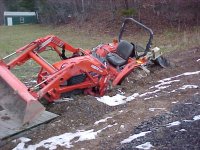My experience is with ag tires. Chains will only make a bigger mess in mud, don't waste your time. With industrial tread, perhaps they help, but if they are making a difference, you probably shouldn't be there to begin with. /forums/images/graemlins/wink.gif If you have turfs, you are trying to float over the top; chains will dig in & sink you, and then you are stuck because you don't have enough grip to push the mud aside & work your way down to solid ground.
For snow & ice, it is most common to see them on the rear wheels, but if you have problems steering putting them on front might be better. I would consult with a dealer before putting them on all 4, as that could overstress the powertrain. Some brands frown on this. A different solution to 4 chains is to properly weight the axle that has chains on it. Getting traction in snow & ice is about getting weight on small points of friction, not adding more & more points. I think manufaturers would prefer you moving in that direction.
Ag tires are designed the way they are because you can't get traction on soft mud. The bars move the soft muck out to the side, as your wheels hunt down deeper for solid dirt - often the sub-soil layer. If the ground is unsolid muck real deep, you will dig down until the frame is sitting in the mud. (Get out of a combine like that & scratch your head wondering what to do.... Been there, done that.) You will notice an ag tire in mud barely moves in reverse, because the lugs pull the soft mud up underneith. Zero traction.
Industrial tires are a compromise of toughness & low profile lugs. If you have these tires, you've stated you do not want to operate in deep mud. You made that choice. Chains might help wipe mud away from the tire, but they are not really adding traction. The chains are more of a bandaid than a solution to mud.
If you have turf tires, you went for floatation. The only way to get over mud with these is to add more rubber surface area - wider tires, or duals. Chains will probably sink you faster in mud than without. You have a floating tire, not a gripping tire. once you cut a rut, you are in trouble. You need to float over the top.
Each tire type serves a purpose, and if you really want to operate in mud frequently, the best bet is to get the right tire. I would not rely upon chains to help me in mud. They do not supply the tread pattern you need to help operate in mud.
Now on ice & snow, you need the hard point penetration to catch on the slippery surface, and chains will help a _lot_ on turfs & industrial tires, and the propper chains that stay on top of the bar lugs will help a lot on ag tires.
It's the best tool for the job thing - using chains in mud means something was wrong from the start. /forums/images/graemlins/smile.gif Look at what you are starting with, and try to help that tool do it's job. Don't try to make the tool behave in a way it was not built to behave. It's a real tuff battle that way. /forums/images/graemlins/smile.gif
--->Paul

